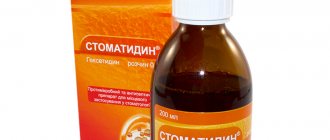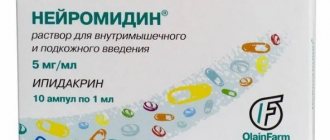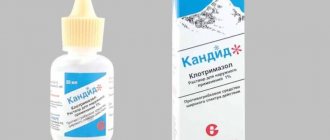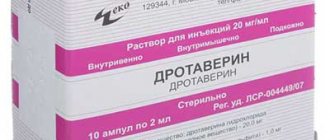Ofloxacin is a broad-spectrum antimicrobial drug. The drug belongs to the fluoroquinlones, so before using it for therapeutic purposes, the patient must be examined. This medicine can affect bacterial enzymes, blocking their activity in the body, and as an addition it has bactericidal properties. If a doctor has prescribed Ofloxacin, the instructions for use should be read carefully to avoid the development of unwanted reactions due to improper use.
pharmachologic effect
The bactericidal effect of ofloxacin is associated with inhibition of DNA gyrase and topoisomerase IV, which leads to disruption of bacterial DNA replication and death of microbial cells.
Ofloxacin has a broad spectrum of antimicrobial action, including microorganisms resistant to other antibiotics, including strains that produce beta-lactamases. Sensitive microorganisms: Aeromonas hydrophila, Moraxella catarrhalis, Brucella spp., Chlamydia trachomatis, Citrobacter freundii, Clostridium perfringens, Enterobacter aerogenes, Enterobacter cloacae, Escherichia coli, Haemophilus ducreyi, Haemophilus influenzae, Haemophilus parainfluenzae, Helicobacter coli, Helicobacter jejuni, K Lebsiella oxytoca, Legionella pneumophila, Morganella morganii, Mycoplasma hominis, Neisseria gonorrhoeae, Neisseria meningitidis, Plesiomonas spp., Proteus mirabilis, Proteus vulgaris, Salmonella enteric, Serratia marcescens, Shigella spp., Staphylococcus spp. (coagulase-negative strains), including Staphylococcus aureus (methicillin-sensitive), Yersinia enterocolitica.
Moderately sensitive microorganisms: Acinetobacter calcoaceticus, anaerobes (Bacteroides fragilis), Chlamydia psittaci, Gardnerella vaginalis, Mycobacterium tuberculosis, Mycobacterium leprae, Pseudomonas aeruginosa, Streptococcus pneumoniae, Streptococcus spp.
Resistant microorganisms: Acinetobacter baumannii, Clostridium difficile, Enterococcus spp., Listeria monocytogenes, Staphylococcus aureus (methicillin-resistant), Nocardia asteroides.
Features of good stagnation
There is no evidence of drug administration in patients who experienced few serious adverse reactions in the past with the use of quinolones or fluoroquinolones (section “Adverse reactions”). Treatment of these patients with ofloxacin should begin only if alternative treatment options are available and after a thorough assessment of the crust/rhizica (see also section “Contraindications”).
If the patient becomes ill, it is recommended to switch to regular doses of ofloxacin tablets.
If allergic reactions or side effects develop in the central nervous system (CNS), the drug should be taken carefully.
The drug should be used with caution in patients with diseases of the central nervous system (affected by atherosclerosis of the cerebral vessels, acute insufficiency of cerebral blood flow), or with impaired cerebral function.
Patients with acute liver failure should not exceed the dose of 400 mg per dose.
Patients must drink enough water to eliminate the crystalluria.
Ofloxacin should be administered by continuous intravenous infusion over a period of 60 minutes. Rapid or bolus injections may lead to arterial hypotension. Ofloxacin is not the drug of first choice for the treatment of pneumonia caused by pneumococci or mycoplasmas, or acute tonsillitis caused by β-hemolytic streptococci.
If you prescribe ofloxacin for intravenous administration simultaneously with antihypertensive drugs, you may avoid a rapid decrease in arterial pressure. In such cases, or when the drug is prescribed simultaneously with anesthetics of the barbiturate class, it is necessary to monitor the function of the cardiovascular system.
For methicillin-resistant S. aureus
(MRSA) there is a very high incidence of concomitant resistance to fluoroquinolones, including ofloxacin. In connection with this ofloxacin, there are no recommendations for the treatment of known or suspected infections caused by MRSA, due to outbreaks, if laboratory results have confirmed the sensitivity of the microorganism to ofloxacin (antibacterial agent and, according to recommendations for the treatment of infections caused by MRSA, cannot be cured).
Infections caused by Escherichia coli
Resistance of E. coli –
The most common cause of infection of the kidneys is to fluoroquinolones in various countries of the European Union.
Physicians who prescribe therapy are advised to assess the local range of resistance of E. coli
to fluoroquinolones.
Infections caused by gonococci (Neisseria gonorrhoeae)
Due to increased resistance of N.gonorrhoeae
ofloxacin should not be considered as an empirical approach to antibacterial therapy in case of suspected gonococcal infection (gonococcal urethritis, inflammatory diseases of the pelvic organs and epididymo-orchitis), in addition to seizures, if the patient has been identified and confirmed to be sensitive to ofloxacin. If after 3 days of treatment clinical improvement has not been achieved, therapy must be reviewed.
Illness of the pelvic organs
To treat inflammation of the pelvic organs, ofloxacin should be combined with drugs that are active against anaerobic microorganisms.
Hypersensitivity and allergic reactions
Allergic reactions and hypersensitivity reactions have been reported after taking an initial dose of fluoroquinolones. Anaphylactic and anaphylactoid reactions may progress to life-threatening shock after taking an initial dose. In such cases, it is important to immediately discontinue ofloxacin and begin prompt treatment (for example, treatment for shock).
Severe bullous reactions
Episodes of severe bullous skin reactions, such as Stevens-Johnson syndrome and toxic epidermal necrolysis, have been recorded in response to the use of ofloxacin (section “Adverse reactions”). In case of a guilty reaction on the side of the skin and/or mucous membranes, patients are advised to urgently contact their doctor, first of all continue treatment.
Sickness caused by Clostridium difficile
Diarrhea within an hour or after treatment with ofloxacin (including a decade after treatment), especially severe, accompanied by bleeding and/or bleeding, may be a symptom of pseudomembranous colitis. Level of severity of illness associated with Clostridium difficile,
varies from mild to severe, life-threatening, pseudomembranous colitis (section “Adverse reactions”). Therefore, it is important to consider this diagnosis in patients who develop severe diarrhea within an hour or after treatment with ofloxacin. If there is no suspicion of pseudomembranous colitis, ofloxacin must be carefully taken away. Immediately begin specific antibiotic therapy (for example, oral vancomycin, oral teicoplanin, or metronidazole). In this clinical situation, drugs that suppress intestinal motility are contraindicated.
Patients with precariousness before trial
Quinolones can reduce the threshold of criminal activity and provoke criminal prosecution. Ofloxacin is contraindicated for use in patients with a history of epilepsy (section “Contraindications”). Like other quinolones, this trace should be used with extreme caution in patients who are susceptible to trial, and with immediate treatment with active drugs that lower the trial threshold, for example, theophylline (division “Interactions with other medicinal agents and other types of interactions”). If court attacks are to blame, ofloxacin must be discontinued.
Trivals, disabling and potentially irreversible serious adverse reactions
In very rare episodes in patients who were treated with quinolones and fluoroquinolones, regardless of the age and obvious risk factors, they were told about trivals (over a period of months or years), disabling and potentially irreversible serious adverse reactions that occur at different times, and sometimes at a time, systems of the body (zocrema, musculoskeletal, nervous, psyche and organs). Be sure to take the drug immediately after the first signs or symptoms of any serious adverse reaction appear and then consult your doctor.
Tendonitis and tendon rupture
Tendinitis and tendon rupture (not interconnected by the Achilles tendons), or bilateral, may occur as early as 48 years after treatment with quinolones and fluoroquinolones and, as reported, will continue for many months after the celebration. The risk of developing tendonitis and tendon rupture increases in patients of advanced age, patients with impaired muscle function, patients with whole organ transplantation and patients. c, who were treated with corticosteroids simultaneously. Thus, there is a trace of the uniqueness of the one-hour stagnation of corticosteroids.
At the first signs of tendinitis (for example, pain, soreness, inflammation), treatment with the drug should be given immediately, and an alternative treatment should also be considered. Damaged end(s) must be properly cleaned (for example, immobilization). Corticosteroids do not prevent any signs of tendinopathy.
Patients with impaired nirofunction
Use caution when prescribing the drug to patients with impaired neuronal function. It is necessary to adjust the dose and time of administration of the drug to patients with nicotine deficiency and to patients of the summer age who have been successfully treated by a doctor (section “Method of dosage administration”).
Extension of the QT interval
In very rare cases, patients who took fluoroquinolones were advised to prolong the QT interval. Fluoroquinolones, including ofloxacin, should be used with caution in patients with known factors at risk of prolongation of the QT interval, before intermittent use:
- unregulated disturbances in electrolyte balance (for example, hypokalemia, hypomagnesemia);
- congenital low QT syndrome;
- to increase the QT interval;
- heart disease (for example, heart failure, myocardial infarction, bradycardia);
- concomitant use of medications with a known effect on prolonging the QT interval (for example, antiarrhythmic drugs of classes IA and III, tricyclic antidepressants, macrolides, antipsychotics);
- Summer age patients and women may be more sensitive to drugs that prolong the QT interval. Therefore, caution should be exercised when administering fluoroquinolones, including ofloxacin, to these groups of patients.
Aneurysm and destruction of the aorta
Epidemiological studies show increased risk of aneurysms and aortic rupture after taking fluoroquinolones, especially in late-life patients.
Therefore, fluoroquinolones should be used only after a thorough assessment of the cortex/rhizica and after considering other treatment options in patients with a positive family history of aneurysm or in patients with a diagnosis of aortic aneurysm and/or disarticulation of the aorta, or in the presence of risk factors that cause aneurysm and
destruction of the aorta (for example, Marfan syndrome, Ehlers-Danlos syndrome, Takayasu arteritis, gigantoclitin arteritis, Behcet's disease, hypertension, atherosclerosis).
In cases of acute abdominal pain, pain in the chest or back, patients should immediately consult a doctor for emergency assistance.
Patients with a history of psychotic disorders
There have been reports of psychotic reactions in patients who took fluoroquinolones. In some episodes, these reactions progressed to suicidal thoughts or self-destructive behavior, including attempts at self-destruction, sometimes after a one-time administration of the drug. If the patient develops a reaction, discontinue ofloxacin and undergo proper clinical care. It is necessary to administer ofloxacin with caution to patients with a history of psychotic disorders or to patients with mental illnesses.
Patients with impaired liver function
Use ofloxacin with caution in patients with impaired liver function through the possible deterioration of the liver after taking the drug. They reported on episodes of bliskavich hepatitis, which could potentially lead to episodes of liver failure (including fatal ones), and were treated with fluoroquinolones. Patients are advised to undergo treatment and contact their doctor if they experience symptoms and signs of liver disease such as anorexia, irritation, dark spots, itching or abdominal pain when burning patients (division “Adverse reactions”).
Patients taking vitamin K antagonists
Through possible advances in coagulation test values (prothrombin hour/international normalized blood flow (INR)) and/or bleeding in patients, in order to remove fluoroquinolones, including ofloxacin, from the combination with vitamin K antagonists (for example, warfarin), in cases of one-hour stagnation Two groups of medicinal agents should monitor the results of coagulation tests (section “Interactions with other medicinal agents and other types of interactions”).
Myasthenia
Fluoroquinolones, including ofloxacin, may have a nerve-muscle blockade effect and may exacerbate muscle weakness in patients with myasthenia gravis.
During the postnatal period in patients with
myasthenia gravis
from fluoroquinolone ingestion, there were associated serious adverse reactions, including fatal episodes and cases that required treatment. encouragement dikhannya.
Ofloxacin is not recommended for use in patients with
a history myasthenia gravis
Prevention of photosensitivity
Episodes of photosensitivity in aphids after treatment with ofloxacin have been recorded (section “Adverse reactions”). Patients taking ofloxacin should not receive intense sleep light and ultraviolet light (mercury-quartz lamps, solariums) before the hour of treatment and for 48 years after taking the drug. Ikarsky specially for preventing photosensitivity.
Superinfection
Taking antibiotics, especially during the first hour, can lead to increased growth of resistant microflora, so before the hour of treatment it is necessary to periodically check the patient's position. If the culprit is a secondary infection, follow the next steps.
Peripheral neuropathy
Episodes of peripheral sensory or sensorimotor polyneuropathy, leading to paresthesia, hypoesthesia, dysesthesia and weakness, have been reported in patients who were withdrawing from quinolones and fluoroquines. loni (including ofloxacin). In case of severe symptoms of neuropathy, such as pain, liver, tingling, numbness or weakness, patients taking the drug should inform their doctor to avoid the development of the necessary potential company camp (div. section “Additional reactions”).
Dysglycemia
During the inhalation of quinolines, including ofloxacin, disturbances in blood glucose levels, including the appearance of both hyperglycemia and hypoglycemia, have been reported, especially in patients with diabetes , which avoided concomitant treatment with the administration of an oral hypoglycemic agent (for example, glibenclamide) or insulin. Learn about episodes of hypoglycemic coma. For patients with diabetes, close monitoring of blood glucose level is recommended (section “Adverse reactions”).
Patients with glucose-6-phosphate dehydrogenase deficiency
Patients with latent or confirmed glucose-6-phosphate dehydrogenase deficiency may be susceptible to hemolytic reactions when treated with quinolones. Therefore, it is necessary to prescribe ofloxacin to these patients with caution to control the potential for hemolysis.
Destroyed dawn
If you take ofloxacin, you may experience any damage to your vision or side effects on the side of your eye organs, you should immediately go to the ophthalmologist (see section “The importance of the risk of reactions when using a car transport or other mechanisms" and "Adverse reactions").
Pool on the results of laboratory tests
During the course of treatment with ofloxacin, clinically positive results from the use of opiates or porphyrins may be prevented. More specific methods may be required to confirm positive test results for opioids or porphyrin.
Patients with rare seizure disorder
Patients with rare seizure disorders such as galactose intolerance, lactase deficiency or glucose-galactose malabsorption should not take this medication.
The drug should contain 365.47 mg/dose of sodium, which should be used with caution in patients on a sodium-controlled diet.
Suspension during pregnancy or breastfeeding.
Investigations on animals revealed damage to the subglobular cartilage in immature animals, and teratogenic effects continued throughout the day. Therefore, ofloxacin is contraindicated for use during pregnancy.
Ofloxacin is excreted in breast milk in small amounts. Due to the possibility of the development of arthropathy and other serious types of toxicity in infants who are breastfeeding, during the hour of treatment with ofloxacin, the breast develops a trace of pinching.
This is due to the fluidity of the reaction during treatment with vehicles or other mechanisms.
The fluidity of psychomotor reactions may be impaired, resulting in interference with transport mechanisms and mechanisms.
The fragments in several episodes indicated drowsiness, disruption of the cervical function by mechanisms, confusion and disorder of the eyes after taking the drug, patients should be aware of the reaction of their body to ofloxacin before keruvat transport. them in their own ways or work with the mechanisms.
Pharmacokinetics
At the end of a 30-minute intravenous infusion of 200 mg ofloxacin, serum concentrations are 5.2 mg/l, 4 hours after infusion - 1.1 mg/l, after 12 hours - 0.3 mg/l. Quickly penetrates and is well distributed in many organs, tissues and body fluids, penetrates into cells. Therapeutically significant concentrations exceeding serum concentrations are observed in interstitial tissue, saliva, sputum, lung tissue, myocardium, bones, intestinal mucosa and wall, peritoneal fluid, pancreatic juice and pancreatic tissue, prostate, seminal fluid, organs of the female reproductive system , skin and subcutaneous tissue; penetrates leukocytes and alveolar macrophages. The distribution volume is 120 l. Penetrates well through the blood-brain barrier, reaching therapeutic concentrations; in high concentrations passes through the hematoplacental barrier and is excreted in breast milk. About 25% of the administered dose is bound to blood plasma proteins. The half-life is 4.7 - 7 hours and does not depend on the administered dose. With repeated administrations, the cumulative effect is not pronounced, serum concentrations increase slightly. After administration at a dose of 200 mg, the total clearance is 258 ml/min. Ofloxacin is excreted predominantly by the kidneys unchanged - 80 - 90% of the administered dose, creating high concentrations in the urine. In small quantities it is excreted through the intestines. About 5% of the administered dose undergoes biotransformation in the liver; the main metabolites are ofloxacin N-oxide and N-dimethylofloxacin, which are excreted by the kidneys. In patients with renal impairment, the half-life of ofloxacin is prolonged; total and renal clearance decrease in proportion to the decrease in creatinine clearance. During a hemodialysis session, 10–30% of the drug is removed.
Overdose
The most important signs of acute overdose include symptoms from the side of the central nervous system, confusion, confusion, disorientation, drowsiness, confusion, hypotension, seizures, prolonged QT interval, and reactions on the side of the intestinal tract, such as tediousness, vomiting, erosive swelling of the mucous membranes.
There is no antidote. Likuvannya is more symptomatic. Ofloxacin is initially administered directly (75–80% of the administered dose is seen in the unchanged state immediately after stretching
24–48 years), its elimination can be accompanied by forced volumetric diuresis. Some ofloxacin can be removed from the body by hemodialysis (average 15–25%) or peritoneal dialysis (less than 2%).
It is necessary to monitor ECG readings as soon as possible after extending the QT interval. To protect the mucous membrane of the mucous membrane, it is recommended to use antacids.
Indications for use
Infectious and inflammatory diseases caused by microorganisms sensitive to ofloxacin: kidney, urinary tract, prostate; gonococcal urethritis; skin and soft tissues; bones and joints; female genital organs; abdominal cavity and biliary tract; ENT organs, with the exception of cases of acute tonsillitis caused by β-hemolytic streptococcus (some strains of β-hemolytic streptococcus are only partially sensitive to ofloxacin, so it should not be used as a first-line drug for acute tonsillitis caused by β-hemolytic streptococcus) ; lower respiratory tract, except in cases of established or suspected pneumococcal infection (some strains of Streptococcus pneumonia are only partially sensitive to ofloxacin, so it should not be used as a first-line drug for community-acquired pneumonia caused by this pathogen); septicemia. Prevention of infections in patients with impaired immune status (including neutropenia).
Showing
Infectious-flammable illness caused by ofloxacin-sensitive pathogens:
- acute chronic obstructive pulmonary disease (including chronic bronchitis)*, non-hospital pneumonia*;
- uncomplicated acute cystitis*, urethritis*, acute pyelonephritis and complicated infections of the genital tract;
- complex infections of skin and soft tissues*.
Follow official recommendations to ensure proper use of antibacterial drugs.
*if it is not possible to use other antibacterial agents, which may make it difficult to treat the infection.
Contraindications
Hypersensitivity to fluoroquinolones and excipients of the drug, children under 18 years of age, patients with glucose-6-phosphate dehydrogenase deficiency; patients with epilepsy (including a history), decreased seizure threshold (including after traumatic brain injury, stroke or inflammatory processes in the central nervous system); if there are indications of tendon damage due to previous use of fluoroquinolones.
Carefully
Severe atherosclerosis of cerebral vessels, cerebrovascular accidents, including a history of other organic lesions of the central nervous system, renal dysfunction, prolongation of the QT interval, simultaneous use of drugs that reduce the threshold of convulsive readiness of the brain, such as fenbufen, theophylline; drugs that can lower blood pressure, drugs for non-inhalation general anesthesia from the group of barbiturates (increased risk of hypotension); liver failure; known risks of QT prolongation (older age, uncorrected electrolyte disturbances (hypokalemia, hypomagnesemia), congenital long QT syndrome, heart disease (heart failure, myocardial infarction, bradycardia), concomitant use of drugs that can prolong the QT interval (see section " Interaction with other drugs")); myasthenia gravis; hepatic porphyria; history of psychosis and other mental disorders; severe adverse reactions to other quinolones, such as neurological reactions (increased risk of similar reactions when using ofloxacin); in patients with diabetes mellitus taking oral hypoglycemic agents (for example, glibenclamide) or insulin (the risk of hypoglycemia increases).
Use during pregnancy and breastfeeding
The drug is contraindicated during pregnancy. If it is necessary to use the drug during lactation, breastfeeding should be stopped.
Contraindicated
- Increased sensitivity to ofloxacin and to other components of the drug or other drugs of the fluoroquinolone group;
- epilepsy;
- damage to the central nervous system (CNS) due to a decreased threshold (after traumatic brain injury, stroke, inflammation of the brain and meninges);
- history of tendinitis;
- deficiency of glucose-6-phosphate dehydrogenase;
- Children or young children in the growth phase, as well as women in the period of gestation or breastfeeding, fragments of evidence of the experimental treatment of the drug in animals indicate those who cannot completely turn off its negative effect on cartilage. globs of a growing organism.
Ofloxacin cannot be prescribed to patients with a prolonged QT interval, patients with uncompensated hypokalemia, or patients taking class IA antiarrhythmic drugs (quinidine, proc. їnamіd) or class III (amiodarone, sotalol).
special instructions
Ofloxacin is not the drug of choice for diseases of the upper and lower respiratory tract caused by pneumococci.
As with other fluoroquinolones, due to possible photosensitization, it is recommended to avoid prolonged exposure to direct sunlight or ultraviolet radiation.
Rarely, tendinitis can lead to tendon rupture (mostly the Achilles tendon), especially in older patients. If signs of tendinitis occur, you should immediately stop treatment, immobilize the Achilles tendon and consult an orthopedist.
In the presence of severe liver disease, individual selection of the dose of the drug is required depending on the degree of liver dysfunction.
If severe and prolonged diarrhea occurs during or after treatment with ofloxacin, it is necessary to exclude the development of pseudomembranous colitis (immediate discontinuation of the drug and oral administration of vancomycin and metronidazole are required). Drugs that suppress intestinal motility are contraindicated.
Ofloxacin inhibits the growth of Mycobacterium tuberculosis, which may lead to false negative results of bacteriological tests in patients with tuberculosis.
During treatment, the course of myasthenia gravis may worsen and attacks of porphyria may increase in predisposed patients.
When determining porphyrin in urine, a false positive result may be obtained.
For the treatment of mixed aerobic-anaerobic infections (peritonitis, endometritis and others), it is recommended to combine ofloxacin with one of the antianaerobic antibiotics that have antianaerobic activity.
The drug should be used with caution in patients predisposed to the development of seizures (patients with a history of lesions of the central nervous system, patients taking fenbufen or other non-steroidal anti-inflammatory drugs that reduce the threshold of convulsive readiness of the brain, as well as other drugs that reduce the threshold of convulsive readiness of the brain , such as theophylline) (see section "Interaction with other drugs").
In very rare cases, prolongation of the QT interval has been observed in patients taking fluoroquinolones. In the following patient groups with known risk factors for QT prolongation, the use of fluoroquinolones, including ofloxacin, should be used with caution (monitoring the QT interval):
— elderly patients;
- patients with uncorrected disorders of the electrolyte composition of the blood, such as hypokalemia, hypomagnesemia;
— congenital long QT syndrome;
- heart diseases (such as heart failure, myocardial infarction, bradycardia);
- simultaneous use of drugs that can prolong the QT interval (classes IA and III antiarrhythmic drugs, tricyclic antidepressants, macrolides, terfenadine) (see section “Interaction with other drugs”).
Sensory and sensorimotor neuropathy, which may have a rapid onset, has been reported in patients receiving fluoroquinolones, including ofloxacin. If patients develop symptoms of neuropathy, treatment with ofloxacin should be discontinued to help minimize the possible risk of developing irreversible conditions.
Interactions with other medicinal drugs and other types of interactions
Like other fluoroquinolones, ofloxacin should be used with caution in patients who take drugs within the QT interval (for example, antiarrhythmic drugs of classes IA and III, tricyclic antidepressants, macrolides, antipsychotics) (section “QT interval maintenance” in the section “Peculiarities” zastosuvannya»
).
With one-hour administration of ofloxacin and anticoagulants, an increase in bleeding was reported.
When combined with non-steroidal anti-inflammatory drugs (NSAIDs), such as nitroimidazole and methylxanthines, there is an increased risk of developing neurotoxic effects.
With immediate use of glucocorticosteroids, there is a risk of tendon rupture, especially in late-age patients.
Simultaneous administration of ofloxacin with procainamide may lead to an increase in the level of procainamide in patients, requiring close monitoring of the level of procainamide in blood plasma, ECG and at the time of need to adjust the dosage of the drug.
With one-hour administration of ofloxacin with antihypertensive agents or anesthetic barbiturates, rapt depression can be prevented in certain cases.
If you take quinolones at the same time with other drugs that lower the threshold for vascular readiness, for example, with theophylline, you may be careful not to further reduce the threshold for vascular readiness of the brain. However, it is important that ofloxacin, unlike other fluoroquinolones, does not interact pharmacokinetically with theophylline.
An additional decrease in the threshold of vascular readiness of the brain can also occur with one-hour ingestion with NSAIDs, as well as drugs that reduce the threshold of vascular activity.
If you are to blame for a court attack, ofloxacin must be removed.
Ofloxacin may cause slight changes in serum concentrations of glibenclamide; Continue close monitoring of patients to monitor this combination.
The elimination of quinolones may be impaired, and serum levels may be increased if they are taken simultaneously with other medications that detect secretions at the nitric tubules (for example, with probenecid, cimetidine, furosemide and methotrexate).
Upload to the laboratory results:
During the course of treatment with ofloxacin, clinically positive results from the use of opiates or porphyrins may be prevented. It may be necessary to confirm positive test results for opioids or porphyrins using more specific methods.
Mycobacterium tuberculosis is highly sensitive to ofloxacin, which can lead to negative results in bacteriological diagnosis of tuberculosis.
Close monitoring is necessary with concomitant administration of insulin, caffeine, theophylline, cimetidine, cyclosporine, NSAIDs, anticonvulsants, drugs that are metabolized by cytochrome P450.
Vitamin K antagonists
In patients who were weaned off ofloxacin in combination with vitamin K antagonists (for example, warfarin), changes in the indicators of coagulation tests (prothrombin hour/international normalized time) were recorded. Marriage (MNV)) and/or bleeding, which could have been serious.
Close monitoring of coagulation test results is required in patients taking vitamin K antagonists due to the possibility of exacerbating the effects of coumarin-like drugs.
Directions for use and doses
Intravenous drip.
The duration of administration of 200 mg ofloxacin is 30 minutes. Doses are selected individually depending on the location and severity of the infection, as well as the sensitivity of microorganisms and the general condition of the patient.
In patients with normal renal function, the average therapeutic single dose of ofloxacin is 200 mg, administered twice daily with an interval of 12 hours. If the patient's condition improves, the patient is transferred to oral administration of the drug in the same daily dose.
For the treatment of severe infections, including in patients with impaired immune status, the single dose can be increased to 400 mg, which is administered intravenously 2 times a day.
In case of severe liver dysfunction, it is not recommended to exceed the dose of the drug 400 mg/day.
In elderly patients, no adjustment of the dosage regimen is required; however, attention should be paid to the patient's renal function, since if it decreases, a corresponding adjustment of the dosage regimen may be required. The duration of treatment depends on the severity of the disease. Treatment with the drug should continue for at least 48–72 hours after body temperature has normalized or if there is confirmation of eradication of the pathogen.
In patients with impaired renal function, the first loading dose is the same as in patients with normal renal function and depends on the location and severity of the infection.
Subsequently, doses and dosage regimens are established taking into account the value of creatinine clearance (see table).
| Creatinine clearance, ml/min | > 80 | 80 — 50 | 50 — 20 | < 20 |
| Dosage regimen | 200 – 400 mg every 12 hours | 200 – 400 mg every 12 hours | 100 – 200 mg every 24 hours | 100 mg every 24 hours or 200 mg every 48 hours |
| For hemodialysis and peritoneal dialysis: 100 mg every 24 hours or 200 mg every 48 hours. | ||||
Attention!
Ofloxacin solution should not be mixed or dissolved in it with other medications. For infusion of ofloxacin, a separate intravenous system must be used. If there is any unused ofloxacin solution left in the bottle, it should be discarded and not used on other patients.
Ofloxacin solution for infusion 2 mg/ml is compatible with 0.9% sodium chloride solution, 5% dextrose solution.
Reviews
- Anton, 25 years old. The doctor prescribed treatment with Ofloxacin for gonorrhea. I used the drug, strictly following all the doctor’s instructions, and very soon achieved the desired result. Although later treatment was required to restore the stomach. It is a very powerful product and helps get rid of germs, although it is harmful to the body.
- Valeria, 30 years old. I took Ofloxacin to treat a severe cold, but for a long time I could not bring down the temperature. I took the medicine in accordance with medical recommendations, but the results did not please me very much. The main disease was cured, but a couple of times during the course I noticed that my appetite was worsening and my taste sensations were changing, and occasionally I was bothered by tinnitus. But everything returned to normal after the end of therapy.
Side effect
From the digestive system
: nausea, vomiting, diarrhea, flatulence, abdominal pain, increased activity of liver transaminases, hyperbilirubinemia, cholestatic jaundice, hepatitis, decreased appetite, pseudomembranous colitis, enterocolitis (in some cases hemorrhagic), constipation, anorexia.
From the nervous system and sensory organs
: headache, dizziness, uncertainty of movements, imbalance, drowsiness, tremors, convulsions, numbness and paresthesia of the limbs, nightmares, insomnia, psychotic reactions and depression with self-harm, up to suicidal thoughts or attempts, anxiety, state of agitation , phobias, confusion, hallucinations, peripheral sensory neuropathy, peripheral sensory-motor neuropathy, vertigo, increased intracranial pressure, impaired color vision, diplopia, impaired taste, smell, hearing loss.
From the musculoskeletal system
: tendinitis, myalgia, arthralgia, tendon rupture, rhabdomyolysis and/or myopathy, muscle weakness.
From
the cardiovascular system:
“flushes” of blood to the skin of the face, arterial hypotension, collapse (with a sharp decrease in blood pressure, the administration is stopped), tachycardia, arrhythmia (risk factor - hypokalemia, diseases and taking drugs that prolong the QT interval).
Allergic reactions
: skin rash, pustular rash, pruritus, urticaria, purpura, allergic pneumonitis, allergic nephritis, eosinophilia, fever, angioedema, bronchospasm, erythema multiforme exudative (including Stevens-Johnson syndrome) and toxic epidermal necrolysis (Lyell's syndrome), photosensitivity , vasculitis, bullous hemorrhagic dermatitis, anaphylactic shock, cough, nasopharyngitis, shortness of breath.
From the blood system and hematopoietic organs
: leukopenia, agranulocytosis, anemia, including hemolytic and aplastic, thrombocytopenia, pancytopenia, petechiae.
From the urinary system
: acute interstitial nephritis, impaired renal function, acute renal failure, hyperhidrosis, hypercreatininemia, increased urea concentration.
Local reactions
: pain, hyperemia at the intravenous injection site, thrombophlebitis.
Others
: intestinal dysbiosis, superinfection, hyper- or hypoglycemia (in patients with diabetes while taking antidiabetic drugs), exacerbation of porphyria, vaginitis, irritation of the mucous membrane of the eye, fungal infections.
Side effects
Side effects, oriented lower, are classified according to organ systems and frequency of occurrence. The frequency of guilt is classified as follows: often (≥ 1/100 – < 1/10), infrequently (≥ 1/1000 – < 1/100), rarely (≥ 1/10000 – < 1/1000), very rarely (< 1 /10000), the frequency is unknown (cannot be estimated based on obvious data).
Infectious and parasitic diseases
: infrequently - mycosis; resistance of pathogenic organisms.
Damage to the side of the blood and lymphatic system:
very rarely – anemia, hemolytic anemia; leukopenia, eosinophilia; thrombocytopenia; frequency unknown - agranulocytosis, impaired function of the cerebrospinal fluid.
Damage to the side of the immune system:
rarely – hypersensitivity reactions, including anaphylactic/anaphylactoid reactions**, angioedema** (including swelling of the tongue, larynx, pharynx, swelling/swelling of the face); very rarely – anaphylactic/anaphylactic shock**.
Disruption of speech exchange, metabolism:
rarely – anorexia; the frequency is unknown - hypoglycemia in patients with diabetes who take cutaneous drugs, hyperglycemia, hypoglycemic coma.
Mental disorders*:
infrequently - waking up, disturbed sleep, sleeplessness; rarely – psychotic disorders (for example, hallucinations); restlessness, confusion, nightmares, depression; the frequency is unknown - psychotic disorders and depression with self-destructive behavior, including suicidal thoughts or suicide attempts, nervousness.
On the side of the nervous system*:
infrequently – confusion, headache; rarely – drowsiness, paresthesia, dysgeusia, parosmia; very rarely – peripheral sensory neuropathy**, peripheral sensorimotor neuropathy**, musculoskeletal disorders**, extraparamilial symptoms or other disorders of musculoskeletal coordination; unknown frequency – tremor, dyskinesia, ageusia (loss of savory sensations), syncope, benign intracranial hypertension.
Damage to the side of the organs of the eye*:
infrequently - teasing of the mucous membrane of the eyes; rarely - discord the dawn; the frequency is unknown - uveitis.
Damage to the lateral organs of hearing and vestibular apparatus*:
uncommon – vertigo; very rarely - noise in the ears, loss of hearing; frequency is invisible - decreased hearing.
Cardial damage:
rare – tachycardia, frequency unknown – sac arrhythmias, polymorphic sac tachycardia of the “burst” type (the guilt of these reactions was reported especially in patients with risk factors for low blood pressure) shaft QT); prolongation of the QT interval on the ECG.
Judgment's discord:
often – phlebitis; rarely – arterial hypotension; frequency unknown - during the hour of infusion of ofloxacin, tachycardia and arterial hypotension may occur. In very rare episodes, such a decrease in arterial pressure can be severe.
Damage to the side of the respiratory system, thoracic organs and mediastinum:
infrequently – cough, nasopharyngitis; rarely – shortness of breath, bronchospasm; frequency unknown - allergic pneumonitis, severe back pain.
Schluk-intestinal disorders:
uncommon – abdominal pain, diarrhea, nausea, vomiting; rarely – enterocolitis, sometimes hemorrhagic; very rarely – pseudomembranous colitis*; frequency unknown - dyspepsia, flatulence, constipation, pancreatitis.
Hepatobiliary disorders:
Rarely – increase in the level of liver enzymes (alanine aminotransferase, aspartate aminotransferase, lactate dehydrogenase, gamma-glutamate transferase and/or phosphatase), increase in the level of bilirubin in blood; very rarely – cholestatic diarrhea; frequency unknown - hepatitis, which can be severe**, severe liver disease, including the development of lethal acute liver failure, has been reported, especially in patients with severe underlying liver disease (div. section “Peculiarities of zastosuvannya”).
Change the side of the skin and the under skin:
infrequently – squealing, squealing; rarely – kropivyanka, flushing, heavy sweating, pustular viscera; very rarely - erythema multiforme, toxic epidermal necrolysis, photosensitive reactions**, drug-induced dermatitis, purpura vernacular, vasculitis, which in capillary lesions can lead to necrosis of the skin; frequency unknown – Stevens-Johnson syndrome, acute generalized exanthematous pustulosis, drug addiction, stomatitis, exfoliative dermatitis.
Damage to the side of the musculoskeletal apparatus and tissue*:
rarely – tendinitis; very rarely - arthralgia, myalgia, tendon rupture (Achilles tendon rupture), which can be two-fold and occur for 48 years after the start of treatment; frequency unknown – rhabdomyolysis and/or myopathy, muscle weakness, ulcer distension, ulcer rupture, ligament rupture, arthritis.
Relax on the side of the thyroid system:
rarely – increase in serum level to creatinine; very rarely - gostra nirkova insufficiency; frequency unknown – acute interstitial nephritis.
Inheritance and decline/genetic disorders:
the frequency is unknown - attacks of porphyria in patients with porphyria.
Underlying disorders and reactions at the injection site*:
often - reaction at the site of infusion (pain, redness); unknown frequency – asthenia, pyrexia, pain (including pain in the back, chest and spine).
* There have been reports of occurrences of even rare troubling events (several months or days), disabling and potentially non-negotiable serious adverse reactions that occur in various cases, and sometimes in several times, organ systems (including reactions such as tendinitis, tendon rupture, arthralgia , pain at the ends, impaired walking, neuropathies, associated with paresthesia, depression, vomiting, impaired memory, impaired sleep, impaired hearing, impaired vision, impaired taste and smell), associated with the use of quinolones and fluoroquinolones, regardless of the presence of risk factors (div. section “Peculiarities of stagnation”).
**
Data from post-marketing caution.
Information about suspected adverse reactions.
Reporting suspected adverse reactions after drug registration is an important procedure. This makes it possible to continue monitoring the risk of the disease for a specific patient. Healthcare professionals should report any suspected adverse reactions through the national pharmacovigilance system.
Release form
The medicine is produced in the form of ointments, tablets, injections for injections. The price of the drugs is different, but the pharmacological effect is the same. Ofloxacin ointment is available in 3 and 5 gram weights. Sold in aluminum tubes, each of which is packed in a cardboard box. The package contains instructions for use. Ofloxacin tablets are packaged in 10 pieces in contour cell blisters placed in a cardboard box. As for the solution, this greenish-yellow dosage form is sold in 100 ml dark glass bottles or 1 ml ampoules.
Drug interactions
When taking Ofloxacin, you must tell your doctor about other medications you are taking, otherwise side effects may occur. The medicine is not recommended for use with anti-inflammatory drugs to avoid stimulation of the central nervous system. During treatment with Ofloxacin for diabetes mellitus, blood glucose levels should be monitored. For better absorption, medications containing iron, calcium, sulfates or antacids are recommended to be taken after taking the antibiotic at intervals of two hours. The drug reduces theophylline clearance by 25%.
Ofloxacin during pregnancy
For women while expecting a child, the medicine is prescribed exclusively for local treatment (ointment), which is carried out under the strict supervision of a doctor. Taking the tablet form or injections of Ofloxacin during pregnancy and lactation is contraindicated. If it is necessary for a nursing woman to take medication, then stop breastfeeding the baby during the entire therapeutic course of the antibiotic.
- A little black dress is always in fashion - new items for women with photos
- Moldovan surnames and names - male and female. Endings and declension of Moldovan surnames
- Heel spur - treatment: effective remedies and methods








